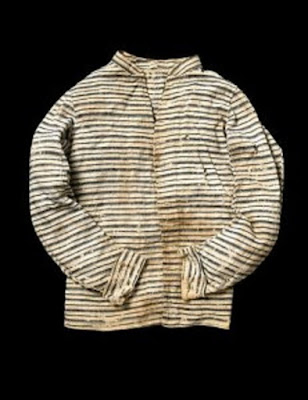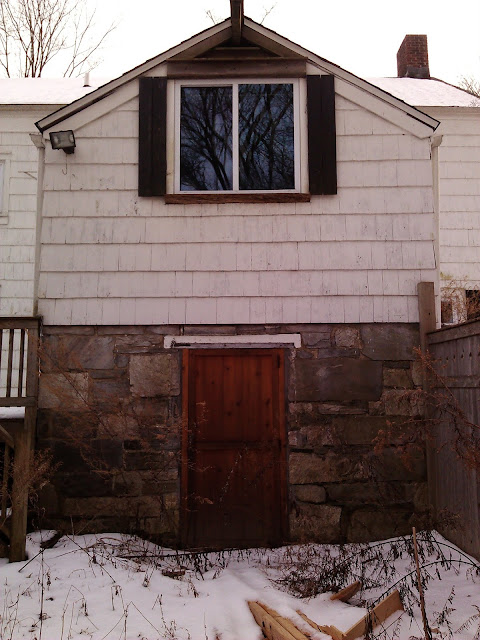 |
| The Benjamin Mead II House (1728) Riversville and Cliffdale roads, North Greenwich. |
Young Obadiah Mead darted from the shadowy barn started running in his father's lane. Even a sixteen year old couldn't outrun a British rifle ball. Obadiah Mead fell dead.
Two women who had been watching the raid from a peephole at the head of the stairs in the family homestead, turned and ran to hide in a closet. There they wept silently, listening for the heavy tread of boots, waiting in apprehension for the first step of the raiders on the stairs.
From the barnyard came a great to-do, cackling and squawking as the British plundered among the terrified fowl. When all was quiet, the women ventured as far as the peephole. The farmyard was deserted. A few feathers blew about. The remaining fowl resumed their scratching and gobbling.
 |
| The shirt worn by Obadiah Mead when he was shot and killed. |
In desperation, the women left the house, their fear centered on what they would find in the lane.
Where were the Mead menfolk when this tragic happening took place? Possibly they were on a remote part of Mead farm or in the tree covered gorge in Byram Woods where the young lad had hoped to find escape.
Mead farm was part of a large land grant of the seventeenth century. It was located on Quaker Ridge, in early times known as Byram Long Ridge. The buildings and farmstead were at the intersection of Cliffdale and Riversviulle Roads. The farm had been handed down from father to son for over 200 years, then in 1896 it passed into other hands.
The old "Revolutionary House" with its peephole over the door was possibly built in 1728. It had loving care through the centuries for it is still standing, the sweep of the roof, the rounded hand-made singles and the glassed in peephole attesting to its antiquity.
In 1808 a two story colonial was built facing Cliffdale Road. The date was carved on the big fieldstone fireplace. Here the Mead's lived until 1911. Solomon Mead had leased the farm from the new owners of 1896 for 15 years.
One of the outstanding features of Mead Farm was its water tower. Built 200 feet from the outbuildings, it stood on a 40 foot rise of ground. The wood-shingled building was 56 feet high, its capacity 7,500 gallons. The water was supplied from a well by a Delameter hot air pump.
The tower was a familiar landmark for miles around, raising its sphinx-like head about the highest part of the farm, it looked over Round Hill, King Street and Long Island Sound.
At the same time the tower was erected, extensive repairs took place on the family home. It is interesting to note that the ancient hand-made nails were resharpened and used again. A new barn was built.
Solomon Mead was a well known stockman. Blooded horses, his own and those he boarded for wealthy New York horsemen, were kept in the stables.
As a precaution against fire, eight fire hydrants were installed around the buildings.
During the disastrous fire before 1911, one of the big barns burned to the ground and some valuable horses were lost. The water supply failed to save the barn but protected the rest of the buildings.
Solomon Mead showed his love for horses by installing a hand pump and large wooden tub at his roadside as well. here teams could stop to drink. It was the only watering trough for miles.
With the coming of power lines to Quaker Ridge, the tower water tank was no longer necessary. During World War II it was used for "skywatch." Let to the vagaries of wind and weather, it began to disintegrate. In 1959 it was torn down.
After 1911 Mead Farm became a "summer place." Among the prominent "summer people" were Walter Huston and J.C. Penny.
The youth who died a martyr to British tyranny lies in an unmarked grave, possibly in the family burying ground over in the orchard. Dangerous times forbade the trip to the Mead burying ground in Cos Cob, and records fail to establish the site of the young lad's unmarked grave.




















